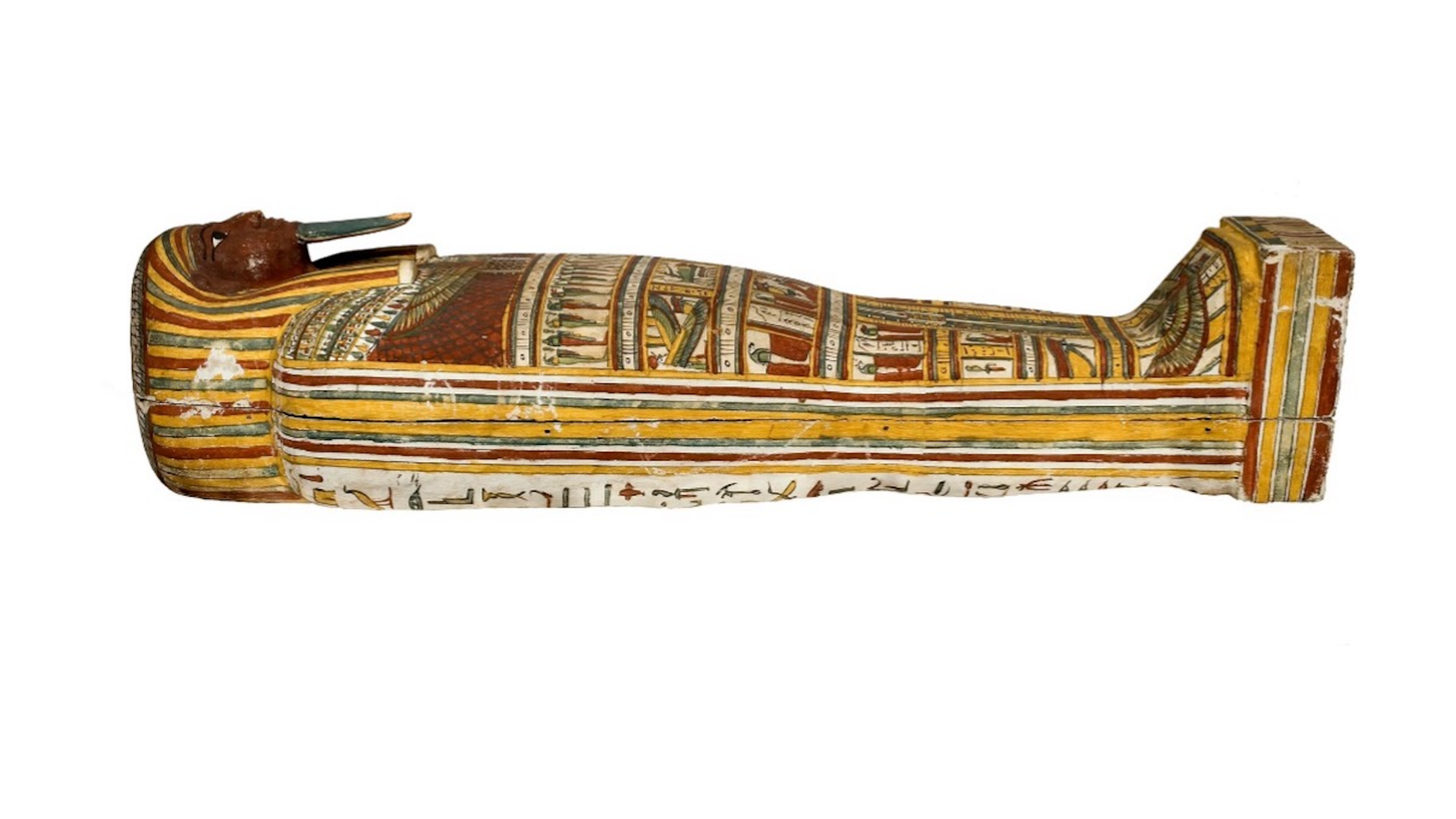How were Ancient Egyptian coffins made? Plaster-like materials hold the answers

Ancient Egyptian artefacts showcase a fascinating variety of plaster-like materials, ranging from true plasters, derived from heated lime and gypsum, to mud, calcium carbonate (limestone), and calcium sulphate mixtures—often bound with organic compounds and enriched with clay minerals or plant fibres. While architectural pastes have been studied, the composition of pastes used on objects remains largely unexplored.
In a recent paper in Journal of Archaeological Science: Reports, by a team of Cambridge researchers, the important role of these pastes in unlocking the past is revealed.
Caterina Zaggia, Marcos Martinón-Torres, Matthew Collins, Helen Strudwick and Julie Dawson collaborated to conduct a detailed materials' analysis of the wooden coffins of Pakepu (ca. 680–664 BCE), a priest and water pourer at the temple of Amun in Thebes. His funerary ensemble consists of an inner and an intermediate coffin, examined alongside contemporary coffin fragments from the same region.
Using optical microscopy, SEM-EDS, and FTIR spectroscopy, a significant contrast between layers was discovered. Similar to much painted ancient Egyptian funerary material, the surface of the intermediate coffin has a simple paste preparation layer under the decoration. However, the inner coffin and fragments have a complex surface structure, similar to cartonnage (a free-standing composite material crafted from layers of linen, glue and paste). Furthermore, it was found that unheated calcite was present in all samples, and that variations in micromorphology and elemental composition suggested that different workshops were used, in addition to a variety of sources of the raw materials and techniques used in production.
The coffin set of Pakepu, E.2.1869 (image © Fitzwilliam Museum)
The coffin set of Pakepu, E.2.1869 (image © Fitzwilliam Museum)
From the top left, comparison samples E.Misc.109.i, E.Misc.119, E.Misc.117 and E.Misc.118.
From the top left, comparison samples E.Misc.109.i, E.Misc.119, E.Misc.117 and E.Misc.118.
Layers of the 'pseudo-cartonnage' present in the comparison fragment E.Misc.117, observed under a digital microscope. The central gap is a crack resulting from deterioration and it is not characteristic of the original stratigraphy.
Layers of the 'pseudo-cartonnage' present in the comparison fragment E.Misc.117, observed under a digital microscope. The central gap is a crack resulting from deterioration and it is not characteristic of the original stratigraphy.
Lead author, PhD student Caterina Zaggia tells us why this matters:
"These pastes are rarely studied in depth, yet they hold crucial insights into ancient production methods, material sourcing, and craftsmanship evolution. Studying Pakepu’s coffins also provides a deeper understanding of how funerary practices and coffin-making techniques evolved at the end of the Third Intermediate Period."
Her research focuses on analyzing different types of pastes used in Egyptian coffins from the Third Intermediate Period (1070-664 BCE). Leveraging the Fitzwilliam Museum’s collections and building on prior research from their Egyptian Coffins Project, her goal is to trace the evolution of these materials from the beginning to the end of the period. She seeks to determine whether a standardized technological tradition existed in Thebes or if variations in raw materials, production techniques, and craftsmanship confirm the widely-held presumption of multiple workshops. Given how little is known about the manufacture of these layers, her work significantly contributes to our understanding of ancient coffin production.
To achieve this, she employs a range of analytical techniques, including optical microscopy (OM), scanning electron microscopy with energy dispersive spectroscopy (SEM-EDS), and Fourier transform infrared spectroscopy (FTIR). Additionally, in collaboration with Matthew Collins and the University of Copenhagen team, she is applying paleoproteomic techniques to investigate the binders used in these pastes. This could reveal a more complex production process than previously understood.
Caterina works under the supervision of Professors Marcos Martinón-Torres and Matthew Collins at the Department of Archaeology, with Helen Strudwick and Julie Dawson from the Fitzwilliam Museum as advisors.
Julie Dawson: Affiliated Researcher (formerly Leverhulme Emeritus Fellow). Julie Dawson is the former Head of Conservation and Scientific Research at the Fitzwilliam Museum (retired May 2021) and was co-lead with Helen Strudwick on the Egyptian Coffins Project from 2014.
Helen Strudwick: Helen Strudwick is Senior Curator (Ancient Nile Valley) at the Fitzwilliam Museum and is responsible for the Museum’s collection of Egyptian Antiquities. Since 2014, with Julie Dawson, she has a led a project to study, document and publish information about the Fitzwilliam’s collection of Egyptian coffins.
Marcos Martinón-Torres: Supervisor of the project and Pitt-Rivers Professor of Archaeological Science.
Matthew Collins: Advisor of the project and McDonald Professor in Palaeoproteomics.
Thanks also to Ismael Rodriguez-Palomo for statistical contributions, Catherine Kneale and Tonko Rajkovaca for their technical support and Tohamy Abulgasim for translating the paper's abstract into Arabic.
Thanks to Dr. Trevor Emmett for his invaluable assistance in identifying the possible quarries of origin and his continuous support in the Ancient Egyptian Coffins Project.
This project has received funding from the European Union’s Horizon 2020 Research and Innovation Programme under the Marie Skłodowska-Curie grant agreement No 956410.

Published 20 February 2025
The text in this work is licensed under a Creative Commons Attribution 4.0 International License





